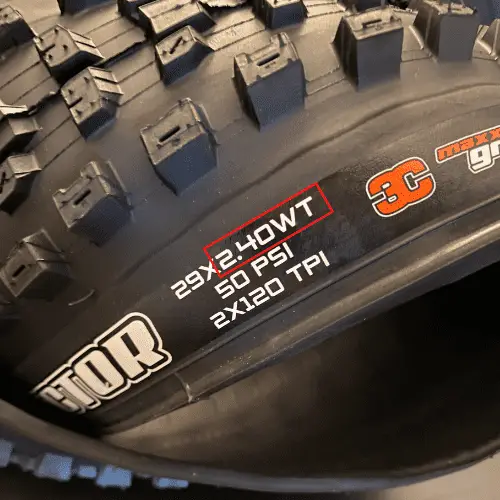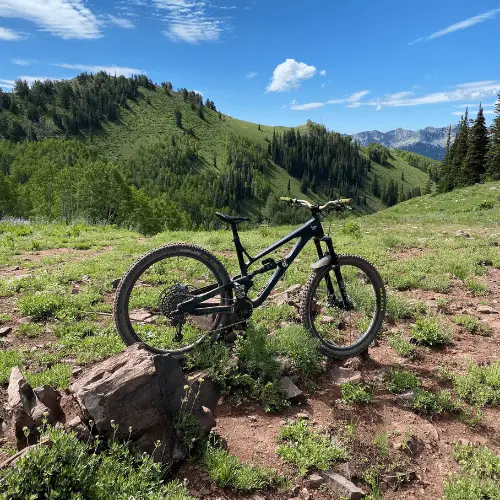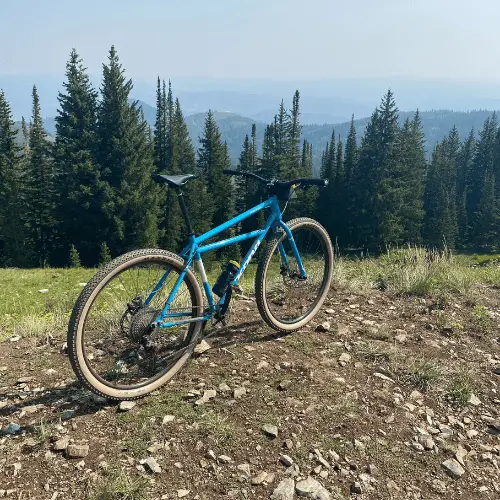Choosing the right mountain bike tire is tough.
There are numerous tread patterns, casings, and widths to choose from. Not to mention that every brand has unique naming conventions.
But today, I’m going to make it easier on you.
This article covers the best mountain bike tire width for both front and rear tires. So let’s get stuck into it.
Disclaimer: This page may contain affiliate links.
What is Mountain Bike Tire Width
Tire width is a measurement used to denote the distance between the two sidewalls of a mountain bike tire. The measurement is displayed in inches and ranges between 2.0” to 3.25” for normal mountain bikes. The tire’s width is printed on the sidewall of the tire.

Why Does Tire Width Matter?
Tire width matters because it affects the ride characteristics of your mountain bike, including traction, rolling speed, and dampening. Manufacturers display tire width to help you choose tires based on the performance characteristics you’re looking for.
Choosing the right or wrong tire will dramatically change the feel and performance of your bike. You don’t want a wide enduro tire with an aggressive slow-rolling tread if you ride cross country.
Tire width also affects tire pressure. You can run lower pressures in wider tires because there is more rubber to maintain the shape. On the other hand, you have to run higher pressures on narrower tires.
It’s the same the other way around. You don’t want a lightweight cross-country tire on your enduro bike, as you’ll be more likely to break your rim.
So what is the best mountain bike tire width?

The Best Mountain Bike Tire Width
The best mountain tire width depends on numerous factors. But as a general rule of thumb, use a 2.1” – 2.3” wide tire on cross country bikes. Use a 2.4” – 2.6” wide tire for enduro and trail.
2.1″ to 2.3″ tires are good cross country tires because they roll fast. The narrow width means that there is less tire touching the ground. Thus, it’s easier for the tire to rotate quickly, aka go fast. This is called rolling speed. It’s common to hear people talk about “how fast a tire rolls.” This is what they’re talking about.
However, there are some drawbacks. Less tire on the ground equates to less traction and vibration dampening. But since cross country trails are smooth, one does not need as much dampening.
2.3″ – 2.6″ tires are excellent for trail and enduro riding. Wider tires have a larger footprint, the tire’s surface area touching the dirt. This gives them better traction at high speeds and dampens impacts from rough terrain.
This larger footprint slows down their rolling speed. However, it’s not a big deal. Since trail and enduro riding is more gravity-focused, the slower rolling speed isn’t as noticeable.

But should you run the same tire size front and rear?
Front Tire Size
Choose a wider tire for your front wheel. This gives you more traction for turning and helps take the edge off of big impacts. 2.2″ – 2.3″ is an excellent front tire size for cross country bikes. 2.4″ – 2.6″ is good for trail and enduro mountain bikes.
Rear Tire Size
Choose a narrower tire for your rear wheel. It will help you roll faster and accelerate quicker. 2.0″ – 2.2″ is an excellent front tire size for cross country bikes. 2.3″ – 2.5″ is good for trail and enduro mountain bikes.
Tire Width Depends on a lot of Factors
Tire width is a very nuanced subject. The guidance above are rules of thumb, and the perfect tire width depends on a lot of personal factors.

Frame Clearance
First is frame clearance. Your bike can only fit a certain tire width. Too wide and it will rub on the frame. You can find the max tire size your bike is compatible with on the bike’s website or in the users manual.
Terrain
Next is the terrain. Wide tires easily float across the terrain while narrow tires cut through the terrain. If you ride somewhere really loose, sandy, or dusty, a wide tire is your friend. If you only ride hard-packed dry trails, a narrow tire will work well.
Riding Preference
Lastly is riding preference. If you ride trail, enduro, and downhill, you want a wider tire to eat up the bumps and give you more grip. If you ride mellower trails or cross country, a narrow tire will roll faster and make it easier to pedal.
I hope this helps you choose the right tire width. If you have any questions or want to chat further, leave a comment or shoot me an email.



Comments are closed.